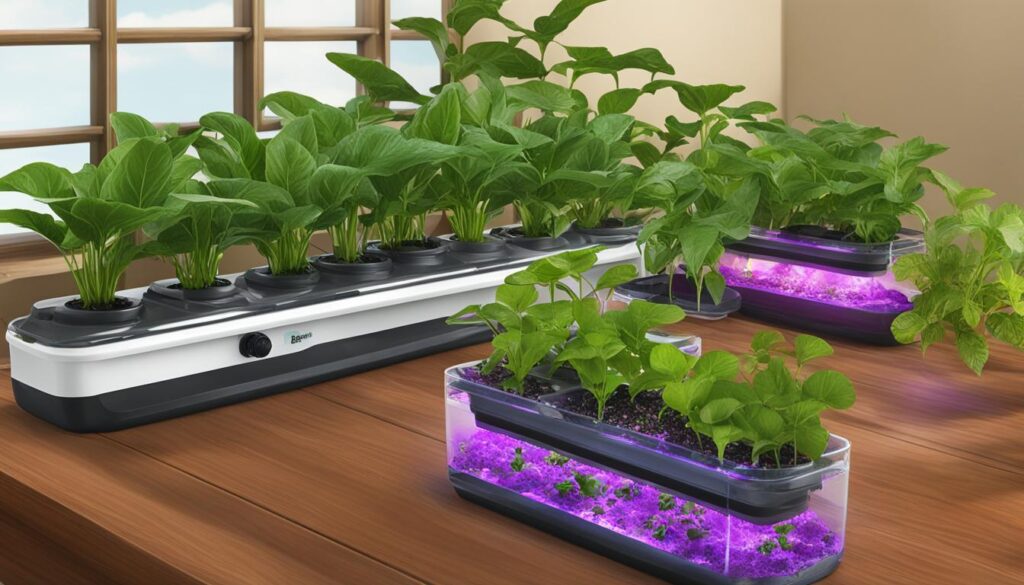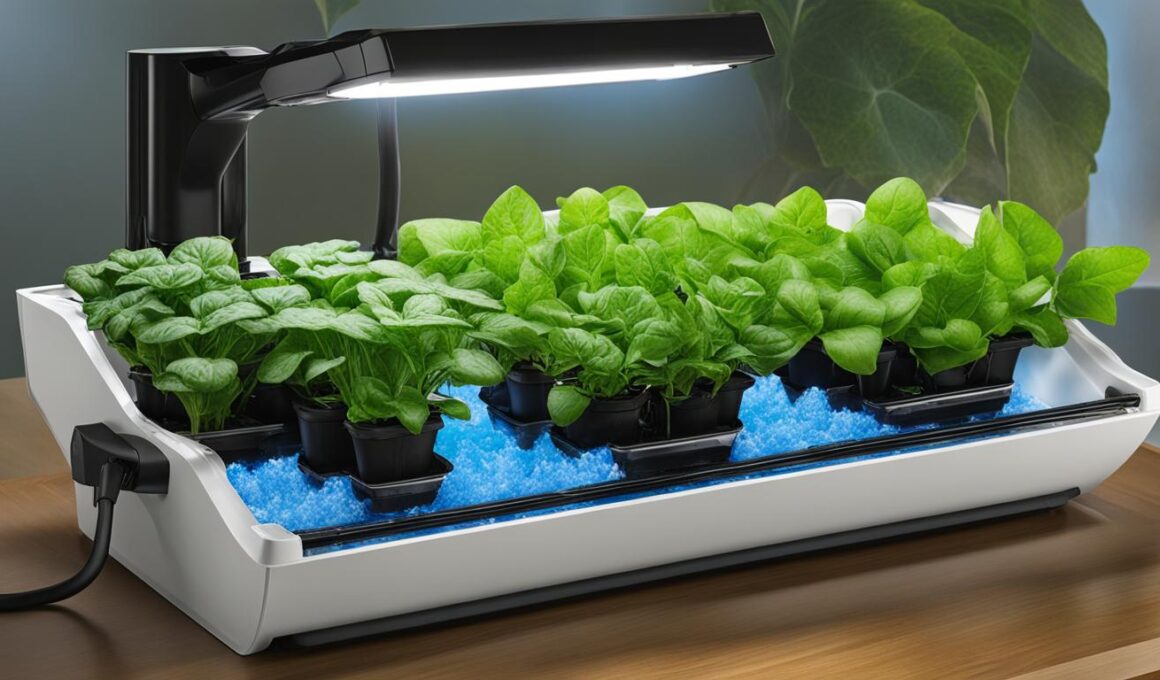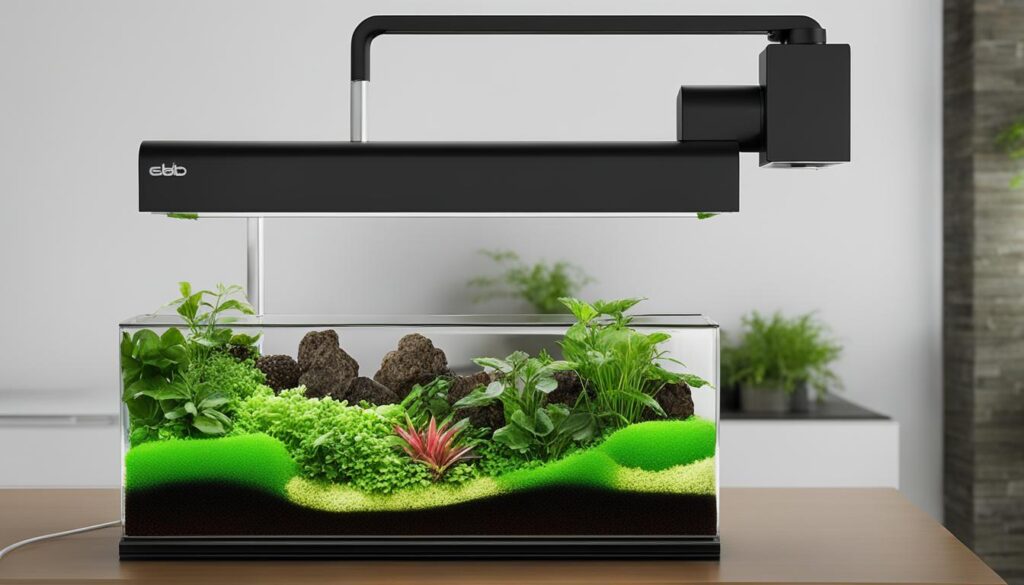The Ebb and Flow system, also known as the Flood and Drain hydroponics system, is a popular and versatile hydroponics method. It involves periodically flooding and draining nutrient-rich water to the plants’ roots. Let’s explore the pros and cons of this system and how it can shape your gardening experience.
Post Summary
- The Ebb and Flow system is a versatile hydroponics method that periodically floods and drains nutrient-rich water to the plants’ roots.
- This system is known for its simplicity and low initial investment cost.
- The basic components of an Ebb and Flow hydroponics system include a plant tray, a growing container, an overflow tube, a nutrient solution reservoir, a growing medium, and a submersible pump.
- Cucumbers, lettuce, and tomatoes are among the best plants to grow in an Ebb and Flow system.
- An Ebb and Flow system operates by periodically flooding the grow tray with nutrient solution and then draining it back into the reservoir, ensuring optimal water and nutrient distribution to the plants’ roots.
Introduction to Ebb and Flow Hydroponics
Ebb and Flow hydroponics, also known as the Flood and Drain system, is a popular and affordable method for growing plants without soil. This system utilizes an inert growing medium to anchor the plant roots and temporarily hold water and nutrients. The beauty of Ebb and Flow lies in its simplicity and versatility, making it suitable for both beginner and experienced gardeners.
With Ebb and Flow hydroponics, the growing tray is periodically flooded with nutrient-rich water, saturating the growing medium and providing the plants with essential elements. Once the flooding is complete, the excess water drains back into the reservoir, allowing the roots to access oxygen. This flood and drain cycle ensures that the plants receive the water and nutrients they need to thrive.
This hydroponics system is particularly well-suited for small to medium-sized gardens or indoor setups due to its low initial investment cost. It’s also highly customizable, allowing growers to adjust watering frequency and duration based on the specific needs of their plants. Whether you’re growing leafy greens, herbs, or even flowering plants, Ebb and Flow hydroponics can offer a reliable and efficient way to cultivate a wide range of crops.
Benefits of Ebb and Flow Hydroponics
- Low initial investment cost
- Easy customization of watering cycles
- Efficient use of water and nutrients
- Versatility for growing various plant types
- Reliable and efficient growth of plants
“Ebb and Flow hydroponics provides an innovative way to grow plants without soil, offering convenience and efficiency to gardeners of all levels.”
As you delve into the world of hydroponics, Ebb and Flow is definitely a system worth considering. Its simplicity, affordability, and versatility make it an attractive option for both hobbyists and commercial growers alike. In the following sections, we will explore the basic components of an Ebb and Flow system, the best plants to grow using this method, and how to set up and manage your own hydroponic garden.
Basic Components of an Ebb and Flow Hydroponics System
The Ebb and Flow hydroponics system comprises several essential components that work together to create an efficient and effective growing environment for your plants. Understanding these components is crucial for setting up and maintaining a successful Ebb and Flow system for your hydroponic gardening needs.
Here are the key components of an Ebb and Flow hydroponics system:
- Plant Tray (or Flood Tray): This is the container where your plants are placed. It holds the growing medium and allows for the circulation of the nutrient-rich water.
- Growing Container: The growing container is positioned beneath the plant tray and holds the nutrient solution. It is connected to the plant tray through an overflow tube.
- Overflow Tube: This tube helps regulate the water level in the plant tray, preventing it from overflowing.
- Nutrient Solution Reservoir: The reservoir stores the nutrient solution, which is periodically pumped into the plant tray.
- Growing Medium: An inert growing medium, such as rockwool or clay pebbles, is used to anchor the plants’ roots and provide support.
- Submersible Pump: The submersible pump is responsible for pumping the nutrient solution from the reservoir into the plant tray, creating the flooding effect.
Each component plays a vital role in the Ebb and Flow system, ensuring that your plants receive the necessary water, nutrients, and oxygen for healthy growth. Now that you understand the basic components, you can proceed with setting up your own Ebb and Flow hydroponics system and enjoy the benefits it offers.

Best Plants to Grow in an Ebb and Flow Hydroponics System
If you’re considering setting up an Ebb and Flow hydroponics system, you might be wondering which plants are best suited for this method. While many plants can thrive in this system, there are a few that particularly excel in an Ebb and Flow environment. Cucumbers, lettuce, and tomatoes are top choices for this type of hydroponics system.
The Ebb and Flow system provides optimal conditions for these plants to grow and yield a bountiful harvest. With precise control over the watering frequency and duration, you can ensure that these plants receive the water and nutrients they need to flourish. Different varieties of cucumbers, lettuce, and tomatoes can be grown, offering a range of flavors, textures, and sizes.
Here is a table summarizing the best plants for an Ebb and Flow hydroponics system:
| Plant | Optimal Growing Conditions |
|---|---|
| Cucumbers | Warm temperature, plenty of water, support for climbing vines |
| Lettuce | Cool temperature, consistent moisture, partial shade |
| Tomatoes | Warm temperature, ample sunlight, sturdy support for vines |
These plants are great choices for an Ebb and Flow hydroponics system because they adapt well to this method and produce excellent results. However, feel free to experiment with other plant varieties to find what works best for your specific gardening goals and preferences.
How Does Ebb and Flow Hydroponics Work
One of the key aspects of an Ebb and Flow hydroponics system is its operation through a cycle of flooding and draining. This process involves periodically flooding the plant tray with nutrient solution, which is then drained back into the reservoir. The system utilizes a submersible pump connected to a timer to control the flooding and draining cycles with precision.
This flood and drain mechanism serves multiple purposes in the Ebb and Flow system. Firstly, it ensures that the plants’ roots receive the necessary water and nutrients for their growth and development. The flooding stage allows the roots to absorb water and nutrients, while the draining stage prevents waterlogging and promotes oxygenation, which is vital for root health.
The Ebb and Flow system operates through gravity and the submersible pump. When the pump is activated according to the predetermined schedule, it pumps the nutrient solution from the reservoir into the plant tray, flooding it with the required amount of solution. The excess solution then flows through an overflow tube back into the reservoir, maintaining a balanced water level in the system.
The ability to control the frequency and duration of the flooding and draining cycles is one of the main advantages of the Ebb and Flow system. This level of control allows gardeners to customize the system according to the specific needs of their plants, ensuring optimal water and nutrient distribution.
Comparative Analysis of Watering Systems
| Hydroponics System | Watering Mechanism | Advantages | Disadvantages |
|---|---|---|---|
| Ebb and Flow | Flood and Drain |
|
|
| Drip Irrigation | Water drips from emitters onto the roots |
|
|
| NFT (Nutrient Film Technique) | Nutrient-rich film flows over the roots |
|
|
The Ebb and Flow hydroponics system provides a unique combination of advantages and disadvantages when compared to other watering systems. While it offers precise control over watering cycles and direct nutrient delivery to the roots, it also comes with potential challenges such as power failures, fluctuating pH levels, and the risk of equipment breakdowns. Evaluating these factors and understanding how the system operates can help you make an informed decision about incorporating Ebb and Flow hydroponics into your gardening practices.
By harnessing the power of flood and drain cycles, the Ebb and Flow hydroponics system provides an efficient and effective method for growing plants in a soilless environment. Whether you’re a beginner or an experienced gardener, understanding the operation of this system can help you achieve successful and thriving plant growth.
Comparison of Ebb and Flow with Other Hydroponics Systems
| Advantages | Ebb and Flow | NFT | Drip Irrigation |
|---|---|---|---|
| Low setup cost | ✓ | ✗ | ✗ |
| Abundant nutrients for plants | ✓ | ✓ | ✓ |
| Customization and scalability | ✓ | ✗ | ✗ |
| Easy to use and manage | ✓ | ✓ | ✓ |
Note: “✓” indicates an advantage of the respective system.
The Cost to Start an Ebb and Flow Hydroponics System
When considering starting an Ebb and Flow hydroponics system, one of the factors to take into account is the cost. The initial setup cost will vary depending on the size and complexity of the system you choose. On average, a 48×24 inch system could cost around $650.
It is important to note, however, that costs can be minimized by using affordable materials and improvising certain components. For example, you can repurpose containers or use PVC pipes instead of buying specific hydroponic equipment. By being resourceful and creative, you can significantly reduce the overall expenses.
Estimated Cost of Starting an Ebb and Flow Hydroponics System (48×24 inch)
| Component | Estimated Cost |
|---|---|
| Ebb and Flow trays | $100 |
| Nutrient solution reservoir | $50 |
| Submersible pump | $50 |
| Growing medium | $30 |
| Timer | $20 |
| Seeds or seedlings | $20 |
| Other accessories (tubing, fittings, etc.) | $20 |
| Total Estimated Cost | $290 |
Keep in mind that the above estimates are just a rough guideline. The actual cost may vary depending on your location, the quality of materials you choose, and any additional features or accessories you decide to include. It’s always a good idea to research prices and compare options before making any purchases.
By weighing the initial investment against the long-term benefits and enjoyment of growing your own plants, you can determine if an Ebb and Flow hydroponics system is the right choice for you.
Different Types of Ebb and Flow Hydroponics
There are various types of Ebb and Flow hydroponics systems, each offering unique features and functionalities to suit different gardening needs and preferences. These variations provide gardeners with the flexibility to customize their setups and maximize their growing potential.
Bench System
One type of Ebb and Flow system is the bench system. This design involves using benches or tables with trays that are flooded and drained periodically. The trays are typically filled with a growing medium, such as rockwool or clay pellets, to anchor the plants’ roots. This type of system allows for efficient use of space and easy access to the plants for maintenance and harvesting.
Bathtub System
The bathtub system is another variation of the Ebb and Flow method. In this system, a large container, such as a plastic bathtub, is used as the flood tray. The container is filled with a nutrient solution, which is periodically pumped in and then drained back into the reservoir. This setup is ideal for growing larger plants or a larger number of plants, as it provides ample space for root development.
NFT System
The Nutrient Film Technique (NFT) system can also be considered a form of Ebb and Flow hydroponics. In this system, a thin film of nutrient solution flows continuously over the roots of the plants, providing them with a constant supply of water and nutrients. The excess solution is collected and recirculated, ensuring minimal waste. The NFT system is commonly used for growing leafy greens and herbs.
These are just a few examples of the different types of Ebb and Flow hydroponics systems available. Each variation offers its own advantages and disadvantages, so it’s important to consider your specific gardening goals and constraints when choosing the right system for you.
Advantages and Disadvantages of Ebb and Flow System
The Ebb and Flow system, also known as the Flood and Drain hydroponics system, offers several advantages that make it a popular choice for gardeners. However, it is important to consider the disadvantages as well before deciding to implement this system in your gardening endeavors. Let’s take a closer look at the pros and cons of the Ebb and Flow system.
Advantages of Ebb and Flow System
- Low setup cost: One of the main advantages of the Ebb and Flow system is its affordability. Compared to other hydroponics systems, the initial investment cost for setting up an Ebb and Flow system is relatively low.
- Easy customization: The Ebb and Flow system allows for easy customization based on your specific gardening needs and preferences. You can adjust the flooding and draining cycles, nutrient solution concentration, and growing medium to create optimal conditions for your plants.
- Nutrient abundance for plants: The periodic flooding and draining of the Ebb and Flow system ensure that the plants receive a constant supply of water and nutrients. This abundance of nutrients promotes healthy growth and can result in higher yields.
- Ease of use: The Ebb and Flow system is relatively easy to use and manage, making it accessible to both beginner and experienced gardeners. Once set up, the system operates automatically, requiring minimal intervention.
Disadvantages of Ebb and Flow System
- Potential power failures: The Ebb and Flow system relies on a submersible pump to control the flooding and draining cycles. In the event of a power failure or pump malfunction, the plants may not receive the necessary water and nutrients, potentially leading to plant stress or death.
- Fluctuating pH levels: Maintaining stable pH levels is crucial for hydroponic systems. In the Ebb and Flow system, the continuous cycling of water can lead to fluctuations in pH levels. Regular monitoring and adjustments may be required to maintain an optimal pH range for plant growth.
- Risk of equipment breakdowns: Like any mechanical system, the Ebb and Flow system is prone to equipment breakdowns and malfunctions. It is important to regularly inspect and maintain the system to prevent any potential issues that may impact plant health.
By considering both the advantages and disadvantages of the Ebb and Flow system, you can make an informed decision about whether this hydroponics method is suitable for your gardening needs. It is essential to weigh the benefits against the potential drawbacks to ensure the success of your hydroponic endeavors.
How an Ebb and Flow System Works
An Ebb and Flow system operates by periodically flooding the grow tray with nutrient solution and then draining it back into the reservoir. This cycle of flooding and draining is controlled by a submersible pump connected to a timer. The pump activates at predetermined intervals, allowing the nutrient solution to flow into the tray, providing the plants with water and nutrients that they need for healthy growth.
Once the tray is flooded, the excess solution drains back into the reservoir through an overflow tube. This drainage ensures that the plants’ roots are not constantly submerged, preventing them from becoming waterlogged and promoting adequate oxygenation. The oxygen-rich environment in the root zone facilitates nutrient absorption and promotes robust plant growth.
The timing and frequency of flood and drain cycles can be adjusted based on the specific needs of the plants being grown. Optimal timing and duration can vary depending on factors such as the type of plants, their stage of growth, and environmental conditions. Fine-tuning these parameters allows for precise control over the water and nutrient delivery, ensuring optimal plant health and yield.
Key Components of an Ebb and Flow System
| Component | Description |
|---|---|
| Plant Tray | A tray or flood table that holds the plants and nutrient solution during the flooding phase. |
| Growing Container | A container that holds the growing medium and anchors the plant roots. |
| Overflow Tube | A tube that allows excess nutrient solution to drain back into the reservoir. |
| Nutrient Solution Reservoir | A container that stores the nutrient solution used in the system. |
| Growing Medium | An inert material, such as clay pebbles or coconut coir, that supports and provides stability to the plants. |
| Submersible Pump | A pump that controls the water flow and timing of the flood and drain cycles. |
The combination of these components, working together in a coordinated manner, creates an efficient system for delivering water and nutrients to the plants’ roots. It allows for precise control over growing conditions, promoting optimal growth and maximizing crop yields.
Benefits and Drawbacks of Ebb and Flow System
The Ebb and Flow hydroponics system, also known as the Flood and Drain method, offers several benefits for gardeners. One of the main advantages is its affordability, making it accessible to a wide range of individuals interested in hydroponic gardening. With a relatively low setup cost, you can start growing plants using this system without breaking the bank.
Another benefit of the Ebb and Flow system is its ease of use. The system operates through gravity and a submersible pump, allowing for precise control of watering frequency and duration. This makes it simpler for both beginner and experienced gardeners to manage the system and provide the necessary water and nutrients to the plants.
Furthermore, the Ebb and Flow system provides an abundance of nutrients for plants. The periodic flooding and draining cycles ensure that the plants receive the water, oxygen, and essential nutrients they need for healthy growth. This results in stronger, more productive plants that can yield a bountiful harvest.
However, it’s important to consider the drawbacks of the Ebb and Flow system. One potential drawback is the risk of equipment breakdowns. Since the system relies on pumps and timers, malfunctions can occur and disrupt the watering cycles, potentially impacting plant health. Additionally, fluctuating pH levels can be a challenge in maintaining optimal conditions for plant growth. Regular monitoring and adjustments may be necessary to ensure a stable pH level.
Benefits and Drawbacks of Ebb and Flow System in a Nutshell
| Benefits of Ebb and Flow System | Drawbacks of Ebb and Flow System |
|---|---|
| – Affordable setup cost | – Risk of equipment breakdowns |
| – Ease of use and management | – Fluctuating pH levels |
| – Abundance of nutrients for plants |
When considering the Ebb and Flow system for your hydroponic garden, it’s essential to weigh these benefits and drawbacks. Assess your gardening goals, budget, and available time for maintenance to determine if the Ebb and Flow system is the right fit for you. With proper planning and care, this versatile hydroponics method can offer an enjoyable and rewarding gardening experience.
Conclusion
The Ebb and Flow hydroponics system is a versatile and accessible method for growing plants. It offers several advantages, including low setup cost, easy customization, and an abundance of nutrients for plants. It allows for efficient use of water and nutrients, resulting in healthier and more productive plants. However, like any system, it has its disadvantages.
Some drawbacks of the Ebb and Flow system include potential power failures that can disrupt the watering cycle, fluctuating pH levels that can affect plant health, and the risk of equipment breakdowns. It is important to consider these factors and weigh them against the benefits before implementing this system in your gardening endeavors.
Whether you’re a beginner or an experienced gardener, the Ebb and Flow system can offer a unique and rewarding growing experience. By understanding how the system works and considering its pros and cons, you can make an informed decision about whether to incorporate it into your gardening practices. Experimentation and adjustments may be necessary to find the optimal timing for nutrient and water cycles, but with time and effort, you can achieve successful results using the Ebb and Flow hydroponics system.
What Are the Pros and Cons of Using Ebb and Flow Systems for Gardening?
When comparing grub prevention products for gardening, ebb and flow systems offer both pros and cons. The controlled water flow promotes efficient nutrient uptake and prevents waterlogging, but it may require additional maintenance and monitoring. While it maximizes growth, it also limits plant variety and root expansion.
FAQ
What is an Ebb and Flow system?
An Ebb and Flow system, also known as the Flood and Drain hydroponics system, periodically floods and drains nutrient-rich water to the plants’ roots.
What are the basic components of an Ebb and Flow hydroponics system?
The basic components include a plant tray, a growing container, an overflow tube, a nutrient solution reservoir, a growing medium, and a submersible pump.
Which plants are best suited for an Ebb and Flow system?
Cucumbers, lettuce, and tomatoes are particularly well-suited for this method.
What are the advantages of an Ebb and Flow hydroponics system?
The advantages include low cost, easy customization, nutrient abundance, and efficient use of water and nutrients.
How much does it cost to set up an Ebb and Flow hydroponics system?
The cost can vary, but on average, a 48×24 inch system could cost around $650.
What are the different types of Ebb and Flow hydroponics systems?
There are various types, including flooding tray designs and ebb-and-flow benches, offering different features and functionalities.
What are the disadvantages of an Ebb and Flow system?
The disadvantages include potential power failures, fluctuating pH levels, and the risk of equipment breakdowns.
How does an Ebb and Flow system work?
The system periodically floods the grow tray with nutrient solution and then drains it back into the reservoir using a submersible pump connected to a timer.
What are the benefits of an Ebb and Flow system?
The benefits include affordability, ease of use, nutrient abundance, and the ability to grow a wide range of plants.
What are the drawbacks of an Ebb and Flow system?
The drawbacks include potential equipment breakdowns, fluctuating pH levels, and the need for trial and error in finding optimal timings for nutrients and water cycles.
How can an Ebb and Flow system enhance your gardening experience?
An Ebb and Flow system offers a versatile and accessible method for growing plants, allowing for customization and providing optimal conditions for plant growth and yield.











